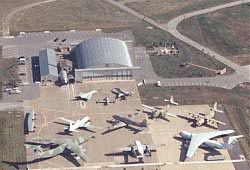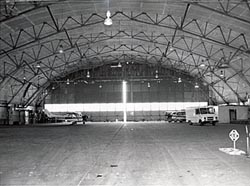
Building 1301, Dover Air Force Base is a single- story, World War II era aircraft hanger and support facility located in Dover, Delaware. Built in 1944 as an experimental station, it is one of the few remaining buildings that have survived from the early years of the Dover Air Force Base (AFB). Building 1301 was constructed during World War II when Dover AFB was used to test and develop rocket-equipped fighters for use in warfare. The facilities constructed for the 4146th Base Unit at Dover consisted of this experimental station (hangar, power plant and shop) as well as an administrative building, barracks area, ammunition magazine and a range area.
Building 1301 consists of three connected sections--hanger, heating plant and shop. The hangar is visible from much of the Air Base, it is much larger than the other two sections, measuring 155 feet wide and 160 feet deep. The curved roof with no internal columns provides a clear height of 42 feet. The hangar was constructed with seven-inch thick, reinforced concrete slab. Aside from the bulk of the hangar, one of the principle architectural features of the building is the set of main hangar doors at each end. The doors consist of a wooden superstructure and a set of sliding doors that provide a clear opening of 28 feet when open and form a solid surface when closed. The interior of the hangar is a vast open space. Attached to the north side of the hangar is the power plant, which was designed as part of the hangar complex. It is a two-story, gable-front cinder-block building. North of the power plant is the shop, connected to the hangar by a long, narrow corridor that forms part of the east wall of the power plant. The shop is a rectangular, wood-frame, single-story, gable-roofed building.

History does not record the individual who first conceived of the idea of using aircraft as a rocket launcher but experiments were being conducted in the United States during the early part of World War II. The first efforts to place rockets on aircraft were tried by the Army Ordnance Department. They used an experimental four-and-a-half-inch rocket that was attached to the wing of a P-40 aircraft at Wright Field in Ohio. The aircraft was flown to Aberdeen Proving Ground in Maryland for test firing. Modifications to the rocket and launcher were needed and testing continued into 1943. The Army Air Force realized that rockets could be a very significant weapon in the air war. By early 1944, the Army Air Force was ready to create a special unit for the continued development of air-launched rockets. The Ordnance Department asked the Army Air Force Commanding General to create the unit at Dover Air Force Base on January 25, 1944. The rocket program at Dover progressed quickly and in July 1944, a civilian engineer, Roy Healy, was sent to Burma to supervise the installation of rocket launchers on the fighting planes to be used against the Japanese in South-East Asia. He provided training and assisted in the field modification of the mounts on the P-51A airplane so that the aircraft could carry both bombs and rocket launchers.
The 4146th also practiced with rockets later used against the Germans with great success. The work in air-launched rockets conducted by the 4146th Base Unit was the beginning of a new type of air combat experience for American pilots and for combat pilots around the world. Inexpensive and efficient rockets made it easier for smaller combat aircraft such as the early jets of the Korean Conflict to move against ground targets that would not have been accessible to traditional bombers. Also, the use of air-launched rockets in aerial combat meant that aircraft could stand off from each other during the engagement and fire at each other using electronic means to lock onto the target instead of using close visual sightings.
Visit the National Park Service Travel American Aviation to learn more about Aviation related Historic Sites.
Last updated: August 29, 2017
